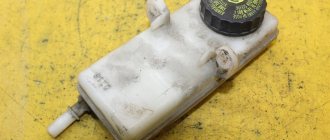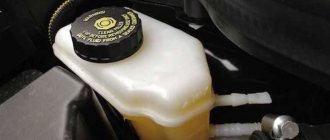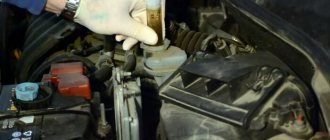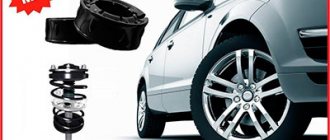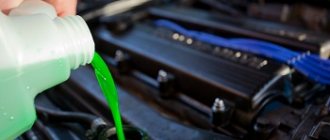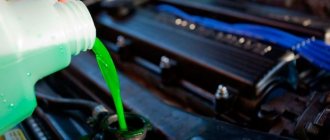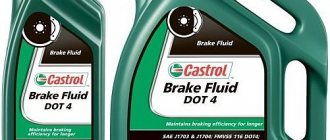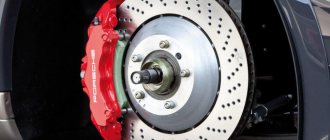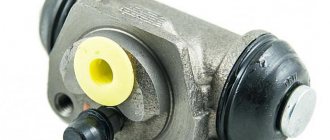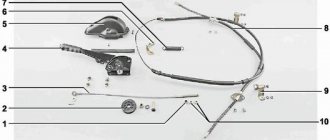Industrial approach
At the factory, the entire brake system is completely empty, but its design is such that the fluid reservoir is located on the main brake cylinder in the engine compartment, at the very top. A little lower is usually the ABS unit (who has it), and then the brake pipes go to the front and rear wheels. There, in wheel brake mechanisms, cylinders of different designs can be used. But one feature unites all of them: a bleeder fitting is always located at the very top of the cylinder. It is also sometimes called an air release valve.
Why do you need to top up your brake fluid regularly?
All working fluids in a car have their own lifespan, after which replacement is required. Each vehicle manufacturer indicates in its operational documentation the recommended maintenance and replacement periods. There are various myths about TJ, common among both novice car enthusiasts and experienced drivers. Let's look at some of them.
Absolute tightness of the brake system. This opinion is fundamentally incorrect, since the system has technological holes through which air moves. Along with the air, water molecules enter the fluid and accumulate in it, causing the properties of the liquid to be lost.
Mixing liquids from different manufacturers is allowed. There are certain peculiarities in this issue. Production standards and chemical compositions may differ and be adapted to a specific vehicle model. If absolutely necessary, mixing is allowed, but experts insist that it is better to fill in a completely new fuel fluid.
It is allowed to fill in various liquids of the DOT-4 standard. As mentioned in the previous paragraph, there are differences in the compositions and properties of TJ. You should not experiment if you do not have the necessary knowledge in this area; it is enough to follow the recommendations of your car manufacturer, fill in compatible fuel fluid and observe replacement intervals.
You may also be interested in: The stove in the car does not heat: all possible reasons and solutions
How often to fill brake fluid
It has already been said above that all regulations for servicing your vehicle, as well as the timing for replacing working fluids, are specified by the vehicle manufacturer. If we talk about the replacement interval, on average it is 40–60 thousand kilometers, or 2-3 years of car operation. It is recommended to rely specifically on the information in your manual, and not on what is indicated by the manufacturer on the packaging.
The numbers on the label can be a marketing tool of an unscrupulous manufacturer to attract buyers.
You should not exceed the recommended periods, and if the car is actively used, it is better to fill in fresh fuel oil more often. This procedure is quite inexpensive, and if you do it yourself it becomes even cheaper.
Every car owner should know where to fill the brake fluid in his car, and before setting off on the road, he should definitely evaluate the external condition of the brake fluid, the color and level in the expansion tank, and top up the brake fluid if necessary. A sharp decrease in level indicates that there is a leak in the system, possible rupture of brake hoses, pipelines, and wear of the seal in the brake cylinders.
If a malfunction is detected, it is strictly not recommended to operate the vehicle; it is necessary to eliminate the cause of the leak and it is advisable to fill in a new fuel fluid, since dirt could get into the system through the leak.
The condition of the vehicle is also monitored during a technical inspection of the vehicle, when oils are changed and minor urgent repairs are performed; most often this procedure occurs in the off-season.
The expansion tank is marked with minimum and maximum levels, which indicate how much brake fluid to fill. It is very important to adhere to this range, do not allow the level to drop below and not overfill above the indicated marks. Failure to comply with this point may result in airing of the system or overflow of excess fluid through the valve of the expansion tank. When traveling long distances, it is advisable to have a small supply of fuel fluid in the car so that, if necessary, you can fill in the missing amount.
You may also be interested in: How to charge a car battery: methods, tips, features
Methods for pumping brakes yourself
Method 1.
The first thing you should do is prepare the new fluid that you will be pouring into the brakes.
Do not forget about the gas stop, which was already mentioned above, this can be the stops of the rear door or hood, and the container into which you will bleed the liquid.
Then you need to add brake fluid to the reservoir if required. After this, feel free to get into the cockpit and prepare the gas stop.
Press the brake pedal up to ten times quickly and sharply, then leave your foot in the locked pressed position.
After this, change your foot to the gas stop, lean it on the seat and make sure that it holds the pedal very tightly and rigidly, and there is no chance that it will come off.
After all these manipulations with the brake, go to the first selected wheel (usually the rear right) and begin to bleed the brake fluid and air from it.
To do this, you need to unscrew the fitting with a small key (pick it up in advance).
While you are bleeding air and fluid, a gas stop in the cabin presses the brake pedal tightly to the floor.
This is much more convenient than asking for help from other people with whom disagreements may arise during work.
Method 2.
In this method we will use a syringe and a transparent hose.
The hose must be selected with such a diameter that the “nose” of the syringe fits tightly into it.
Then everything is simple. We put the hose on the syringe, with one hand we squeeze the latter, pushing out the air, with the other hand we tightly put the hose on the bypass fitting.
Operating principle and possible malfunctions
Where to fill and how to replace brake fluid? Let's answer this question with a short excursion into the principle of operation of the braking system. So, it consists of brake pads, pipes, vacuum, a brake cylinder for each wheel and a master brake distributor cylinder. The period for replacing the fluid depends on the terms set by each manufacturer.
You should read about this in the operating instructions. As a rule, the terms are no more than 3 years or 35,000-40,000 km. mileage
. Depending on the specific operating conditions, the terms may be changed either up or down.
Is it possible to mix different types of brake fluid?
In old cars, BSK brake fluid was once used; it was red in color - the dye was added to it specifically so that fluid leakage could be determined by its color. Modern cars often use yellowish DOT-4 type fluid, and in this case it is impossible to mix liquids of different colors - when mixing BSK and DOT-4, the brake fluid may foam, and the brake cylinder cuffs will also swell.
The basis of modern brake fluids of the DOT-3/ 4/ 5.1 type is polyethylene ethylene glycol, therefore these types of brake fluids are similar in composition. It is permissible to mix them, but it is not advisable, since liquids of different brands differ in characteristics, for example, they have different boiling points.
The basis of DOT-5 brake fluid is silicone, and its composition is in no way compatible with DOT-4 type brake fluid. Mixing DOT-5 and DOT-4 is not allowed; when they are combined, a chemical reaction occurs, as a result of which all rubber seals in the vehicle are corroded.
Which brake fluid to choose
In order to figure out what brake fluid to fill, you need to know what types there are and what parameters you need to pay attention to. There are three types of TJ base, let's look at them:
- Mineral base
. Its main technical characteristics: low aggressiveness of the composition (in relation to rubber seals), good lubricating properties, but at the same time a low operating temperature range (not frost-resistant, boils at low temperatures). Relatively low cost; it is not recommended to be poured into modern cars. - Synthetic base (contains polyglycols and ethers)
. This type is most often used as it has good performance properties. The negative qualities of this type of base include a high level of water absorption, which subsequently leads to internal corrosion of the brake system. - Synthetic base (contains silicone)
. This type of vehicle is one of the most expensive. It has a very low level of water absorption, but is quite aggressive towards rubber components. It is also strictly forbidden to pour it together with other types of fuel fluid.
Today there are a large number of TJ manufacturers on the market. When choosing, it is very important that the properties and technical parameters of the liquid meet the necessary requirements, since the safety of the driver and passengers depends on this. So, what parameters should you pay attention to first?
- Temperature characteristics
During operation of the brake system, a sufficiently high pressure is created inside, due to which the working fluid begins to heat up. The boiling point of the liquid fluid is extremely important, since when the liquid boils the consequences can be disastrous. Initially, the boiling threshold is about +250 °C, but during operation this value begins to fall. The minimum permissible temperature threshold is +165 °C and occurs after approximately two years of operation.
- pH level
This characteristic indicates the level of activity of hydrogen ions. The optimal value should be between 7 and 11.5 pH. At a lower value, the environment is acidic and begins to have a corrosive effect on the steel elements of the brake system. If the pH level increases, the composition becomes alkaline, non-ferrous metals and rubber seals are subject to corrosion.
- Kinematic viscosity
The viscosity value should have the least dependence on temperature, since changing this parameter affects the efficiency of the braking system. At low temperatures, the fluid begins to thicken, in this state it becomes extremely difficult for it to pass through the narrow section of the brake pipes. Viscosity is measured in mm2/s, on all packages it is customary to indicate viscosity at -40 °C, for example, for DOT 4 this value should not exceed 1800 mm2/s, for DOT 6 – 750 mm2/s, but for cold regions this the number should not be lower than 900.
The characteristics listed above allow you to choose a TZ of fairly high quality, but there is no guarantee that the parameters stated on the packaging correspond to reality. In order not to fill your car with a low-quality product and avoid negative consequences during operation, get acquainted with the results of a comparative analysis of several manufacturers. The best products are listed below.
- Castrol is a brake fluid produced by BP Europe. It has excellent viscosity-temperature characteristics and even has an overestimated reserve value. The only drawback is the lack of a sealed valve on the neck.
- Hi-Gear HG7044 - Made in America by Hi-GearProducts. Like the previous model, all the characteristics of the liquid comply with the standards, although there is not the same temperature safety margin.
- PentosinSuper - manufacturer DeutschePentosin-Werke, Germany. TZh fully complies with the standards, is recommended for use in regions with very cold climates, and can be poured at temperatures below -40 ° C.
- Mobil - produced in Europe by ExxonMobilLubricants & Specialties Corporation. In terms of its performance, it is not inferior to the above models, but it does not have a hermetically sealed seal at the neck of the package, that is, there is a risk of water vapor penetration.
- LUXE GreenLine is already a Russian-made diesel engine, a DelfinGroup company. It is also recommended for use, all parameters comply with the standard, so you can safely fill it into your car.
- SINTEC Euro is another Russian-made model from. The product is of very good quality, the actual values of the physical and chemical properties of the fuel fluid exceed the standards.
- ROSDOT 4 LifeSafety is the last copy in the review, also produced in Russia. It deservedly takes its place on the list of recommended brake fluids.
You may also be interested in: How people cheat at car service centers and what you can do to protect yourself
